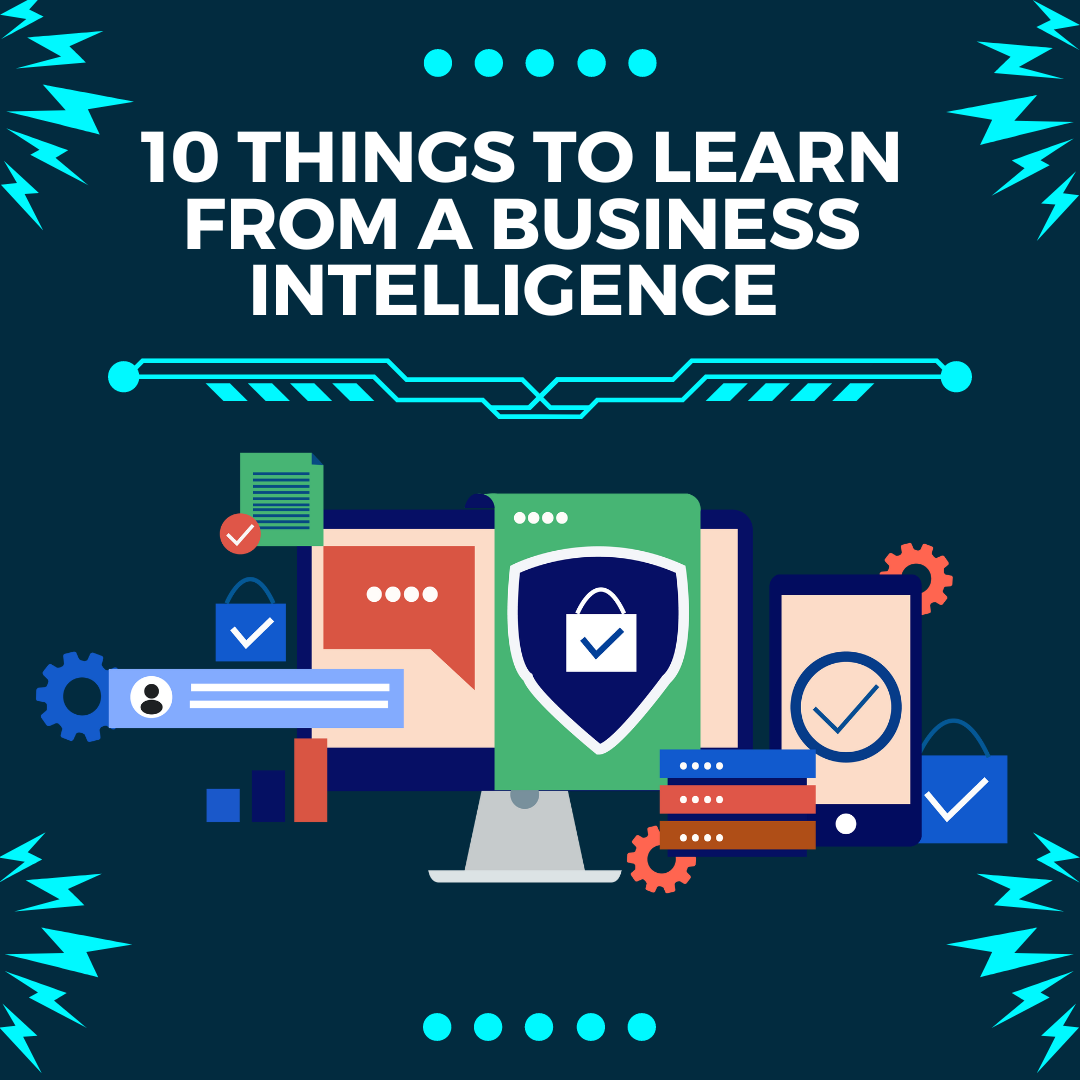Business Intelligence (BI) encompasses technologies, applications, and methodologies used to gather, consolidate, analyze, and present business data. Its principal objective is to enhance organizational decision-making processes.BI encompasses a wide range of tools and methodologies that enable companies to gather data from internal systems as well as external sources, transform it into meaningful insights, and then make data-driven decisions.
1. Importance of Data-Driven Decisions
One of the primary lessons from BI is the importance of making decisions based on data rather than intuition. Data-driven decisions are more objective and can significantly reduce the risk of errors. By analyzing historical data and current trends, businesses can make more informed choices that align with their goals and market conditions.
Benefits:
- Enhanced accuracy in decision-making
- Improved business outcomes
- Reduced risks and uncertainties
2. Understanding Customer Behavior
BI tools help businesses analyze customer data to understand their behavior, preferences, and needs. This understanding enables companies to tailor their products and services to meet customer demands more effectively, leading to increased customer satisfaction and loyalty.
Benefits:
- Better customer insights
- Personalized customer experiences
- Improved customer retention
3. Identifying Market Trends
BI helps organizations stay ahead of market trends by providing insights into industry patterns and competitor actions. By identifying these trends early, businesses can adapt their strategies to capitalize on new opportunities and mitigate potential threats.
Benefits:
- Proactive market positioning
- Competitive advantage
- Timely adaptation to market changes
4. Enhancing Operational Efficiency
BI tools allow businesses to analyze their internal processes and identify areas where they can improve efficiency. By streamlining operations and eliminating bottlenecks, companies can reduce costs and increase productivity.
Benefits:
- Optimized business processes
- Cost reduction
- Increased productivity
5. Measuring Performance
Performance measurement is crucial for any business. BI provides tools to track key performance indicators (KPIs) and other metrics, helping organizations measure their progress towards their goals and make necessary adjustments.
Benefits:
- Clear performance benchmarks
- Data-driven performance evaluation
- Informed strategy adjustments
6. Predictive Analysis
Predictive analysis is a powerful feature of BI that uses historical data and machine learning algorithms to forecast future trends and outcomes. This foresight allows businesses to plan more effectively and stay prepared for potential challenges.
Benefits:
- Improved forecasting accuracy
- Better strategic planning
- Enhanced preparedness for future challenges
7. Improving Data Quality
BI emphasizes the importance of data quality. Accurate, consistent, and timely data is essential for reliable BI insights. Organizations learn to prioritize data governance and implement practices to maintain high data quality standards.
Benefits:
- Reliable insights and reports
- Increased data accuracy
- Enhanced decision-making confidence
8. Integration of Data Sources
BI tools can integrate data from multiple sources, providing a comprehensive view of the business. This integration allows for more holistic analysis and helps break down silos within the organization.
Benefits:
- Comprehensive data analysis
- Unified view of business operations
- Enhanced collaboration across departments
9. Facilitating Collaboration
BI tools often include collaboration features that enable teams to work together more effectively. By sharing insights and reports, teams can align their efforts towards common goals and make collective decisions.
Benefits:
- Improved team collaboration
- Shared understanding of business objectives
- Enhanced collective decision-making
10. Continuous Improvement
Finally, BI promotes a culture of continuous improvement. By constantly analyzing data and seeking ways to optimize performance, businesses can stay competitive and adapt to changing market conditions.
Benefits:
- Ongoing performance enhancement
- Sustained competitive advantage
- Continuous adaptation to change
Implementing Business Intelligence in Your Organization
Understanding the benefits of BI is just the first step. Implementing a successful BI strategy requires careful planning, the right tools, and a commitment to data-driven decision-making. Here’s how you can start:
Step 1: Define Your Goals
Begin by clearly defining what you want to achieve with BI. Are you looking to improve operational efficiency, increase sales, understand customer behavior, or forecast market trends? Having specific goals will help you tailor your BI strategy to meet your unique needs.
Step 2: Choose the Right BI Tools
There are numerous BI tools available, each with its own strengths and weaknesses. Some popular BI tools include Tableau, Power BI, QlikView, and SAP BusinessObjects. Evaluate these tools based on your organization’s requirements, budget, and existing technology infrastructure.
Step 3: Ensure Data Quality
High-quality data is the foundation of effective BI. This may involve cleaning and standardizing your data, setting up data validation processes, and regularly auditing your data sources.
Step 4: Integrate Data Sources
To get a comprehensive view of your business, integrate data from various sources such as CRM systems, ERP systems, social media platforms, and external market data. This integration will enable more holistic analysis and better insights.
Step 5: Train Your Team
Invest in training your team to use BI tools effectively. This includes not only technical training but also training on how to interpret and act on BI insights. Encourage a data-driven culture where employees at all levels use data to inform their decisions.
Step 6: Start Small and Scale
Begin with a pilot project to test your BI strategy and tools. This will allow you to identify any issues and make necessary adjustments before rolling out BI across the entire organization. Once the pilot project is successful, gradually scale your BI efforts.
Step 7: Monitor and Iterate
BI is not a one-time implementation. Continuously monitor your BI processes and tools to ensure they are delivering the desired results. Be prepared to iterate and improve your BI strategy based on feedback and changing business needs.
Future Trends in Business Intelligence
The field of BI is constantly evolving, with new technologies and trends shaping the future of data analytics. Here are some key trends to watch:
Artificial Intelligence and Machine Learning
AI and machine learning are becoming integral parts of BI, enabling more advanced analytics and predictive capabilities. These technologies can uncover hidden patterns in data, automate routine tasks, and provide deeper insights into complex business problems.
Self-Service BI
Self-service BI tools empower non-technical users to analyze data and generate reports without needing assistance from IT professionals. This democratization of data access allows more employees to make data-driven decisions, fostering a culture of analytics throughout the organization.
Real-Time Analytics
This is particularly valuable in industries where timely information is critical, such as finance, retail, and healthcare.
Big Data Integration
As businesses collect increasing amounts of data from various sources, the ability to integrate and analyze big data becomes essential. BI tools are evolving to handle larger datasets and provide more comprehensive analysis, helping organizations make sense of vast amounts of information.
Data Visualization
Data visualization is becoming more sophisticated, with interactive dashboards and advanced visual analytics helping users understand complex data more easily. Effective data visualization can communicate insights clearly and compellingly, making it easier for stakeholders to grasp key findings and take action.
Conclusion
Business Intelligence is a powerful tool that can transform the way organizations operate and make decisions. By learning from BI, businesses can harness the power of data to drive better outcomes, understand their customers, stay ahead of market trends, and continuously improve their performance. Implementing a successful BI strategy requires careful planning, the right tools, and a commitment to data quality and continuous improvement. As BI technologies continue to evolve, organizations that embrace these advancements, including through an Online Data Analytics Course in Noida, Delhi , Mumbai, Indore, and other parts of India, will be well-positioned to thrive in the data-driven future.




2 thoughts on “10 Things to Learn from A Business Intelligence ”